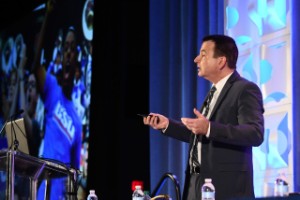
Dr. Timothy Renick, Senior Vice President for Student Success and Professor at Georgia State University, moved attendees to spontaneous applause more than once during his inspiring Sunday opening plenary at AACRAO SEM.
Data analytics may not sound like the most energizing topic to kick off a conference, but Renick’s demonstration of the enormous impact that efficient, targeted, student-centered data analytics has had on his campus, completely eliminating achievement gaps based on race, ethnicity, and income.
Conference kick-off
Before Renick's address, SEM Conference Director Clayton Smith welcomed the more than 800 professionals in attendance.

Noting the Canadian custom of acknowledging the indigenous territory on which the event is being held, Smith observed, "We are on the traditional territory of the primary chiefdom of the Piscataway (or Conoy) Indians, which consisted of five smaller Indian chiefdoms owing allegiance to the largest, the Piscataway. Anacostians, along the Anacostia River – in what is today Washington, D.C., western Prince Georges County, and Alexandria, Virginia."
As the opening day of the conference was November 11 -- Veterans Day-- the South Lakes High School Seahawk Battalion Color Guard from Reston, Virginia, displayed the flag for the national anthem.
Renick: 5 challenges and data-driven solutions
When Renick took the stage, he began by noting that Georgia State has raised graduation rates by 22 percent over the last decade -- despite an increase in Pell recipient students and massive decreases in state funding. GSU also closed all achievement gaps based on race, ethnicity, and income-level. It now awards more bachelor’s degrees to African Americans than any other college or university in the nation.
In a compelling presentation, Renick shared
five of the major challenges faced by his institution, and the steps they took to overcome them. Below is a brief summary.
1. Summer melt
When looking at the obstacles to enrollment, GSU found the finger pointing squarely at itself. Completing the 14 steps (they counted) of bureaucracy required of admitted students was a big differentiator depending on a student’s resources.
So GSU changed the onboarding process, launching a survey of accepted students to begin to understand their interests and challenges and developing a portal to help students through each step of the process, offering resources and tools along the way. The portal interface tracked student progress and prompted interventions if students stopped along the way.
They also introduced an AI-enhanced chatbot for text. In a qualitative follow-up study with students, they found that some students felt more comfortable posing their questions this way rather than to a person. It gave them the resources to find answers themselves, and helped to protect their pride and privacy.
“We had over 201,000 questions answered in one year, and dropped summer melt at Georgia State by 22 percent -- 324 students, mostly students of color, low income students, who were now in their seats, ready to go on the first day,” Renick said.
2. Overwhelming students with choices
GSU has more than 4000 courses and over 100 undergraduate majors. Prior to the change, the average undergrad was going through 2.5 majors before graduation.
“People can’t afford that,” Renick said. “It added time to degree and wasted hours.”
So they changed the onboarding process with regard to selecting academic programs. Now when a student expresses interest in a field, the student portal shows live job data, average time to degree, starting salary, and related fields.
And all students in their first semester are placed in 24-member learning communities around metamajors based on their interests. A faculty member from that area guides orientation.
“Students leave college because they feel like they don’t belong,” Renick said. “This is a low cost way to create a social network. Additionally, students perform better academically and are retained at higher rates.”
As a result, GSU has seen a 30 percent drop in upperclass students changing majors.
3. Getting students through gateway courses
Prior to the change, the drop/fail/withdraw (DFW) rate in gateway classes such as precalculus and college algebra was 43 percent.
Now, these classes are offered in a hybrid emporium model in which every student works on adaptive learning exercises. The DFW rate has dropped to 28 percent, and now faculty in other disciplines are interested in implementing this model.
GSU also has one of the largest near-peer tutoring programs in the country, utilizing work study students who excelled in the class the previous year, and is seeing half a letter grade improvement in GPA with fellow undergrad supplemental instruction
“There’s almost an inverse relationship for students who show up for faculty office hours and those who will show up for a near-peer tutoring sessions,” Renick said. “A lot of first generation students won’t do that (office hours) because they think its their problem. They’re much more likely to go to a tutoring session.”
4. Stop out
Looking for stopout patterns, GSU found the largest subgroup was seniors -- usually the best bet for retention, Renick noted -- but these students were running out of financial aid eligibility within a semester or two of graduating.
“Many students didn’t owe a lot of money,” Renick said. So they came up with the Panther Retention Grant. “Students were asked to do nothing. They didn’t have to raise a hand or come into the office. We knew who were about to drop, close to graduation and taking the right classes.”
The program began small scale and was discovered to be highly effective. With an average grant of $900, about 87 percent of recipients graduated within two semesters. The grants paid off because the university was paying itself.
“This was one of those rare instance where doing the right thing is doing the prudent thing,” Renick said.
5. Staying on track
In what Renick described as possibly the most impactful program, GSU began using analytics in academic advising.
“We identified 800 analytics-based behaviors,” Renick said. Students with any of these alerts were contacted by their advisors within 48 hours. Read more about those interventions here.
These changes results in an 88 percent increase in retention in the first year of implementation. Particularly strong was the improvement in retention among specific cohorts such as transfer and military students. There was also a significant drop -- half a semester -- in the average time to degree.
Impacts
This dramatic decade has changed the identity and profile of campus, Renick noted, with the school being recognized by luminaries such as Bill Gates and President Barack Obama. Additionally, every one percent increase retention rate is worth about three million dollars in additional tuition and fees.
“But we’re not doing it for the attention of Bill Gates or for revenues,” Renick said. “We’re doing it for the students.”
And the biggest gains have come from underserved students, who have not improved incrementally but exponentially.
“We’ve seen the problems we’ve created and have corrected them for all students,” Renick said. “The students who benefit the most are those who got tripped up the most, but the changes weren’t targeting any specific population. At GSU, race, ethnicity, and income levels are no longer predictors about whether a student will graduate.”
Finally, Renick encouraged: “Be innovative, use the data, and make the hard changes -- because the students deserve it.”